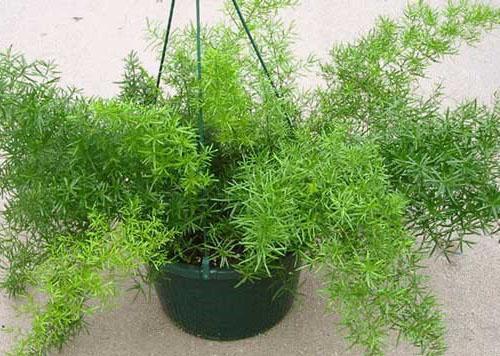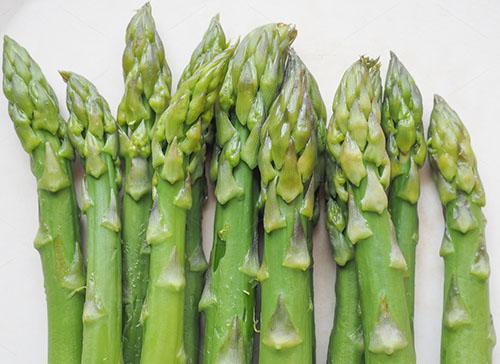Caring for different types of asparagus at home
 Asparagus in indoor floriculture has long been loved. Graceful green twigs not only decorate the composition, but are used in cutting by florists and decorators. The genus of asparagus was presented by the tropics, in the form of shrubs and vines. Plants belong to the asparagus family. In total, there are up to 300 varieties, at times completely different from each other. At home, asparagus are used, unpretentious varieties of keeping conditions.
Asparagus in indoor floriculture has long been loved. Graceful green twigs not only decorate the composition, but are used in cutting by florists and decorators. The genus of asparagus was presented by the tropics, in the form of shrubs and vines. Plants belong to the asparagus family. In total, there are up to 300 varieties, at times completely different from each other. At home, asparagus are used, unpretentious varieties of keeping conditions.
Home care for asparagus

Some types of asparagus are used to obtain an elite food product, asparagus. The shoots of common asparagus, specially cultivated for food use, are used for food. In Germany, one fifth of agricultural land is occupied by asparagus plantations, the shoots of which are manually dug out of the arable layer in spring.
 Breeding asparagus at home is an exciting experience. The flower is relatively unpretentious, but there are certain requirements, without which you can get not an openwork bush, but bare twigs.
Breeding asparagus at home is an exciting experience. The flower is relatively unpretentious, but there are certain requirements, without which you can get not an openwork bush, but bare twigs.
- The lighting should be adequate, but not in direct sunlight. Covering the southern window with tulle is not enough, the plant must be moved a distance. Therefore, it is ideal to use asparagus in a hanging or wall composition. In low light, the leaves turn yellow and fall off.
- The winter temperature of the content during home care should not fall below 10 0, summer comfort is achievable at 22-24 0... Above, in dry air, the needles will begin to dry out. In this case, you need to spray the plant more often.
- Humidity is a prerequisite for the existence of all varieties. To dry out a clod of earth means to destroy the plant. Watering sufficient and regular, spraying in the summer at least twice a day. An air humidifier or a drip tray made of porous materials is required. In winter, depending on the temperature of the content, spraying may be rare.
- Asparagus is a good air purifier from harmful impurities, but does not like drafts.
- There are frequent transfers, but the best way is to transfer.
- In case of violation of agricultural technology, cladonia will signal a change in appearance.
 The maintenance rules are important and are general for the whole species; for each variety of asparagus, agricultural technology has its own characteristics.
The maintenance rules are important and are general for the whole species; for each variety of asparagus, agricultural technology has its own characteristics.
 When purchasing a home flower, you need to familiarize yourself with the peculiarities of caring for a particular variety of asparagus. In indoor breeding, asparagus are most often found:
When purchasing a home flower, you need to familiarize yourself with the peculiarities of caring for a particular variety of asparagus. In indoor breeding, asparagus are most often found:
- asparagus;
- pinnate;
- thinnest;
- Meyer;
- dense-flowered or Sprenger;
- crescent.
Not all are listed, only the most common varieties, but there are many more. With good care, the asparagus you grow may look like the photo in the article.
Asparagus pinnate
 The most delicate openwork greenery in the form of needles resembles a veil.Everything in this plant is graceful, thin needles, numerous branches that create a cascading stream. Caring for feathery asparagus is simple.
The most delicate openwork greenery in the form of needles resembles a veil.Everything in this plant is graceful, thin needles, numerous branches that create a cascading stream. Caring for feathery asparagus is simple.
It must be remembered that it cannot stand the sun's rays, it immediately becomes covered with spots. Spray, water the plant often. This variety is picky about the soil, it should be prepared on the basis of peat, be light, sour. The best composition of the transplant substrate, made up of equal parts:
- peat;
- sand;
- leafy and soddy land;
 The plant is used in landscaping office and residential premises, but it has no place in the bedroom, like other liana-like plants. Plumose asparagus reproduces when seated, dividing rhizomes, grows quickly. Asparagus plumosus Nanus is most suitable for indoor gardening. Overdrying the plant will lead to its death.
The plant is used in landscaping office and residential premises, but it has no place in the bedroom, like other liana-like plants. Plumose asparagus reproduces when seated, dividing rhizomes, grows quickly. Asparagus plumosus Nanus is most suitable for indoor gardening. Overdrying the plant will lead to its death.
Asparagus Meyer
 Mayer's asparagus is distinguished by the particular compactness and beauty of its candle-like brooms. Each shoot individually resembles a dishwashing brush. The plant produces such "candles" more than half a meter long, grows very quickly and requires an annual spring transplant. This plant does not like pruning. You can propagate by dividing the bush and seeds. Compared to feathery, Meyer's asparagus is unpretentious, tolerates temporary drought, but does not tolerate insecticides. Therefore, it is possible to destroy pests on it only with folk remedies.
Mayer's asparagus is distinguished by the particular compactness and beauty of its candle-like brooms. Each shoot individually resembles a dishwashing brush. The plant produces such "candles" more than half a meter long, grows very quickly and requires an annual spring transplant. This plant does not like pruning. You can propagate by dividing the bush and seeds. Compared to feathery, Meyer's asparagus is unpretentious, tolerates temporary drought, but does not tolerate insecticides. Therefore, it is possible to destroy pests on it only with folk remedies.
Asparagus crescent home care
 A native of Africa, this flower in its homeland produces vines up to 15 m long. In indoor conditions, its growth is much more modest. However, its growth still reaches 5 meters, so this species is often grown in greenhouses and botanical gardens. It blooms with small white flowers, gathered in bunches, which have a pleasant smell. This plant does not require special care, it is content with a transplant every few years. On hot days, caring for sickle-shaped asparagus at home consists in frequent watering and moisturizing the leaves. The transplant is combined with reproduction. In addition, this type of asparagus reproduces well by cuttings and seeds. The soil for the plant needs to be prepared slightly acidic, based on peat and leaf humus.
A native of Africa, this flower in its homeland produces vines up to 15 m long. In indoor conditions, its growth is much more modest. However, its growth still reaches 5 meters, so this species is often grown in greenhouses and botanical gardens. It blooms with small white flowers, gathered in bunches, which have a pleasant smell. This plant does not require special care, it is content with a transplant every few years. On hot days, caring for sickle-shaped asparagus at home consists in frequent watering and moisturizing the leaves. The transplant is combined with reproduction. In addition, this type of asparagus reproduces well by cuttings and seeds. The soil for the plant needs to be prepared slightly acidic, based on peat and leaf humus.
Asparagus dense-flowered
 Another name for this plant is Sprenger's asparagus, which does not cause any particular difficulties in caring for it at home. This is an evergreen dwarf shrub with long shoots that softly fall under their weight. The length of these arrows, depending on the conditions of detention, can reach almost two meters. It blooms twice a year with small flowers, the fruits are red berries that are poisonous.
Another name for this plant is Sprenger's asparagus, which does not cause any particular difficulties in caring for it at home. This is an evergreen dwarf shrub with long shoots that softly fall under their weight. The length of these arrows, depending on the conditions of detention, can reach almost two meters. It blooms twice a year with small flowers, the fruits are red berries that are poisonous.
This plant is thermophilic and the temperature in winter should not fall below 15 degrees. For Sprenger, sunlight is not scary. Getting into the shade, the plant stretches the shoots and becomes less decorative. The soil for this variety needs neutral or slightly alkaline, very fertile. Watering is abundant, but in winter with a decrease in temperature, moderate. Caring for Sprenger's asparagus eliminates pruning, this will stop its growth.
The plant is responsive to fertilizing with mineral fertilizers every two weeks during the growing season. This is the only indoor variety that is only happy with direct sunlight.
Signs of impaired development of asparagus
 Every plant possesses signals that signal unhappiness. For this, the general condition of the plant serves. An experienced florist will be able to notice the signal in time and quickly take action:
Every plant possesses signals that signal unhappiness. For this, the general condition of the plant serves. An experienced florist will be able to notice the signal in time and quickly take action:
- the needles crumble and turn yellow, which means that the water balance is disturbed;
- the needles darken and turn brown from the bright color and dry earth;
- light spots appeared - they were not protected from the sun's rays;
- the greens turned pale - add light, you can artificial;
- the bush drooped, look for the reason in the roots;
- the berries are dressed in a gray bloom, gray rot has settled.
 Knowing the disease, it is easy to eliminate it.Therefore, you need to monitor your pets constantly, and they themselves will ask for help. It is impossible to miss the moment of insect pests settling on asparagus. Everyone is scary, but the most dangerous is the spider mite, which is difficult to remove with home remedies, and asparagus do not like it when their delicate needles are exposed to chemistry.
Knowing the disease, it is easy to eliminate it.Therefore, you need to monitor your pets constantly, and they themselves will ask for help. It is impossible to miss the moment of insect pests settling on asparagus. Everyone is scary, but the most dangerous is the spider mite, which is difficult to remove with home remedies, and asparagus do not like it when their delicate needles are exposed to chemistry.